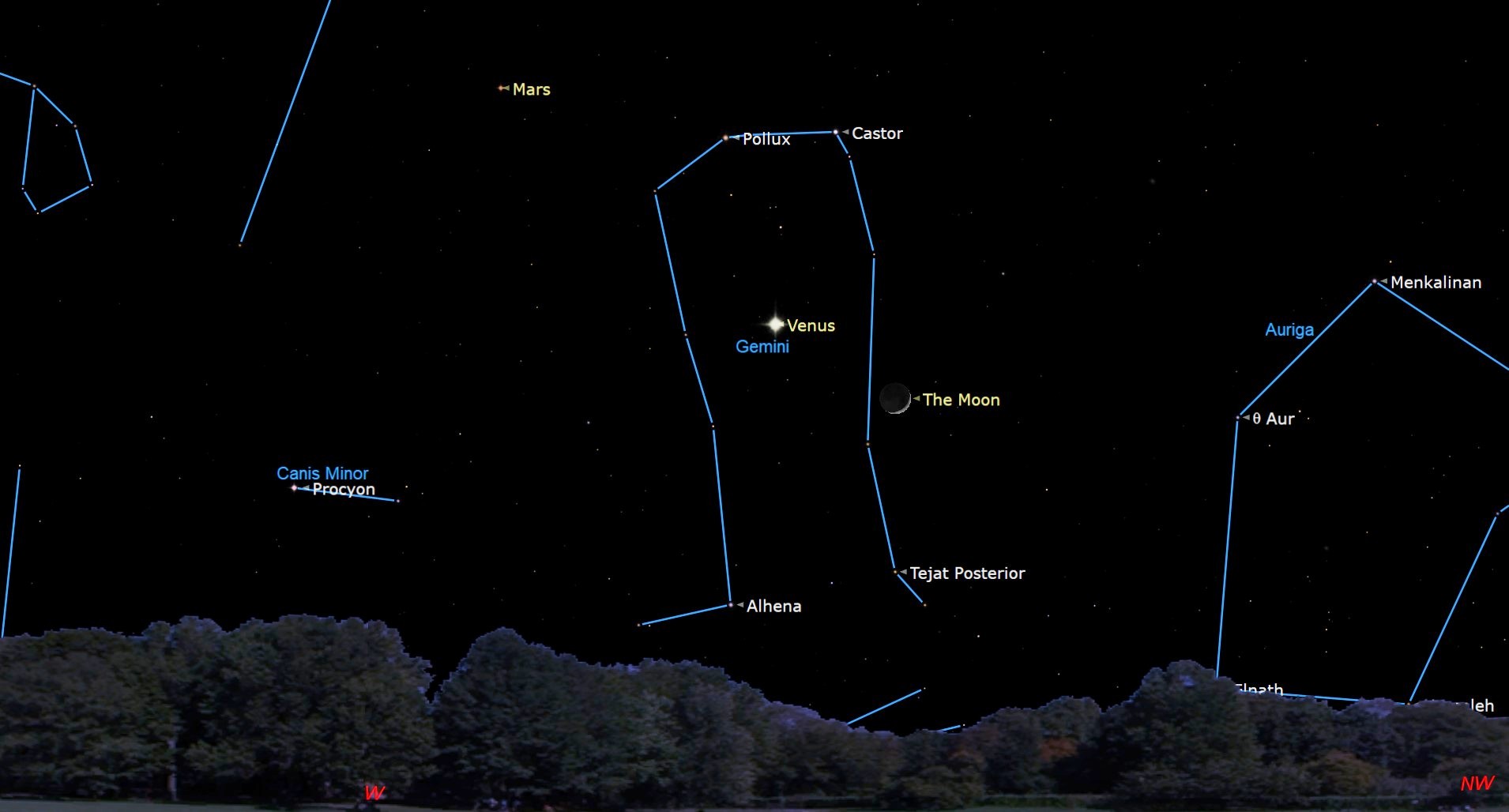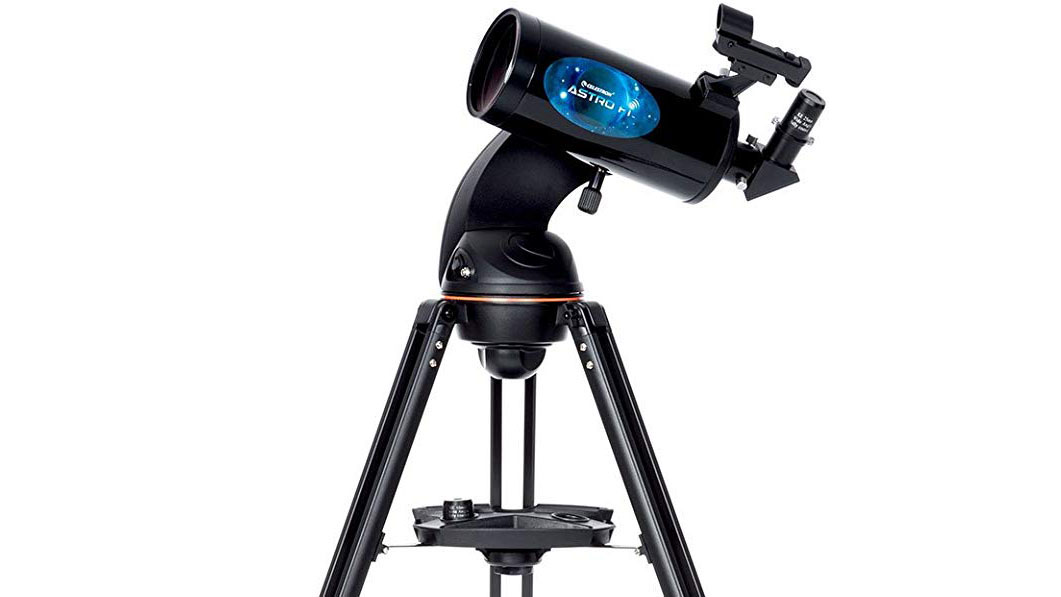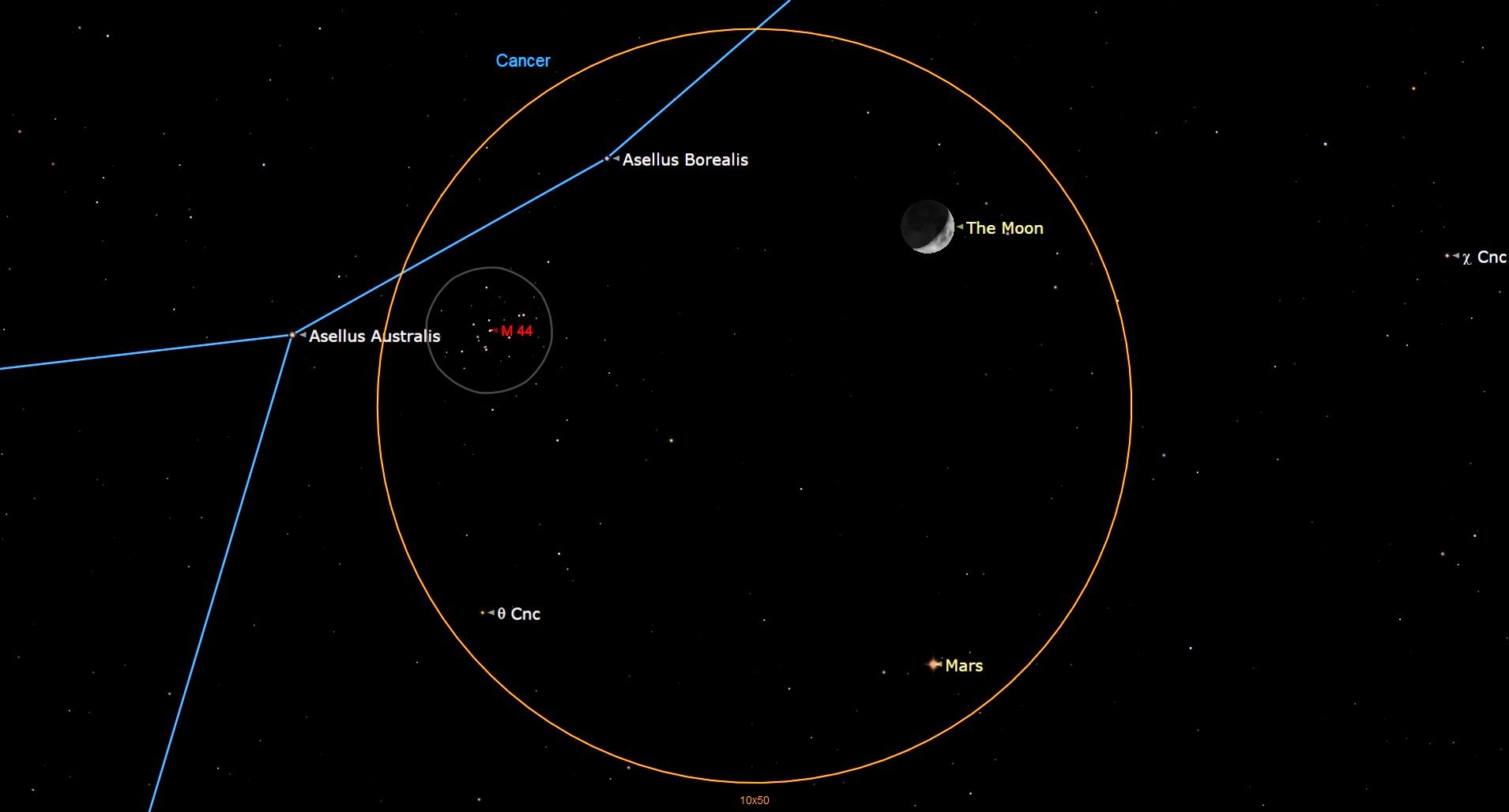
During this upcoming week, we'll be able to watch the moon and two planets engage in an interesting series of configurations with two prominent stars typically associated with the winter season.
The planets are dazzling Venus and much-dimmer Mars. And the two stars belong to the zodiacal constellation of Gemini the Twins: Pollux and Castor.
A wide variety of different conjunctions and configurations involving bright stars and planets typically occur during the course of any given year. It is somewhat unusual, however, when two or more bright planets appear to reside in the same small area of the sky as a pair of noteworthy stars. From our Earthly vantage point, we can readily observe Mercury, Venus, Mars, Jupiter and Saturn with our unaided eyes as they revolve around the sun. Each of these planets appears to move against the starry background at their own speeds and along their own tracks. It is obvious that since they are constantly moving at different speeds, the positions of all five planets at any particular time are unique to that particular moment.
Related: What you can see in the sky tonight [maps]
When and where to look
This will be a changing celestial performance stretched out over four nights from May 21 to May 24. The best time to start looking will be when the sky has turned sufficiently dark, roughly 45 minutes after sunset. Look toward the west-northwest part of the sky, roughly one-third up from the horizon to the point directly overhead (the zenith).
Here is our night-by-night chronology:
Sunday evening (May 21)
You'll see Venus, glowing brilliantly against the cobalt-blue twilight sky. Shining directly above it will be two stars, appearing only about 1/170 as bright as the "Queen of the Night." These are the "Twin Stars," Pollux (on the left) and Castor, marking the heads of Gemini the Twins. Pollux has an orange hue and shines a bit brighter than bluish Castor. These are stars more typically associated with the winter season, which are now bidding us a fond adieu before they disappear into the sunset fires in another few weeks.
Get the Space.com Newsletter
Breaking space news, the latest updates on rocket launches, skywatching events and more!
The Greeks named the constellation's two brightest stars after the twins who hatched from an egg from their mother, Leda, following her seduction by Zeus and were therefore sometimes called the Ledean stars. The Twins were also among the heroes who sailed with Jason in the quest for the Golden Fleece. They helped save the great ship Argo from sinking during a storm, an incident which gave the Twins their reputation as the patron saints of sailors and guardians and protectors of seamen.
On this night, geometricians will take a special interest in the pattern composed of Venus and the Twin Stars, for they will form a nearly perfect, albeit inverted, isosceles triangle. The vertex angle is marked by Venus. The base angles are marked by Pollux and Castor, which are 4.5 degrees apart and the congruent sides or "legs" measure roughly 8.9 degrees; the angular distances from Venus to both Pollux and Castor.
Try using this triangle as a celestial yardstick. In fact, if you draw an imaginary line about 15 degrees to the upper left of Venus, you'll come to a yellow-orange object somewhat similar in brightness to Pollux and Castor. That will be Mars. Then go 15 degrees in the opposite direction from Venus, to the lower right, and there, low above the west-northwest horizon will be the narrow (6-percent illuminated) waxing crescent moon; our nearest neighbor in space will become far more prominent on the nights to come.
Earthshine (May 22 and May 23)
On May 22, a thicker (11-percent illuminated) crescent moon will have shifted closer to Venus and by May 23, the lunar sliver, now 18 percent wide, will have moved to Venus' upper left.
As the sky darkens on both evenings, look to see if you can make out the beautiful effect of Earthshine. It may appear that you'll be able to faintly see the entire disk of the moon; along with the bright crescent, the rest of the moon may appear dimly illuminated with a sort of bluish-gray glow.
To hear more about this lunar phenomenon, watch this interview I conducted with FoxWeather.com this week explaining the "Da Vinci glow" and the upcoming array of stars and planets that can be seen near to it during early next week.

Want to get a good look at the night sky? We recommend the Celestron Astro Fi 102 as the top pick in our best beginner's telescope guide.
To better understand what you are seeing, try to imagine if you were an astronaut on the lunar surface and looking up toward Earth. What you would be seeing is the Earth going through phases in the same manner that the moon goes through phases as seen from Earth. But there's an important difference: the phase of the Earth as seen from the moon is exactly the opposite to the phase of the moon as seen from the Earth! Astronomers refer to this phenomenon as "complementary phases." Thus, on these nights, while the moon will appear as a mere skinny sliver from our Earthly perspective, as viewed from the moon, the Earth would appear as an almost fully-illuminated disk, nearly four times larger in size and dozens of times brighter than our own full moon. Since much of the moon that is turned toward the Earth is currently in darkness, the only thing that is illuminating the lunar landscape is the light of the nearly full Earth itself.
That's why the dark part of the moon appears faintly illuminated; because of the light provided by that almost full Earth! This dim "Earthshine" is sometimes referred to as "The old moon in the new moon's arms." Check out both the moon and Venus in binoculars: the moon will appear as a three-dimensional ball as it hangs near Venus, itself glowing like a dazzling white jewel.
Wednesday evening (May 24)

To cap things off on this final night of our celestial array, the widening moon sits directly above Mars. The red planet continues to fade as it recedes from Earth at the rate of 31,370 miles (50,480 km) per hour. On this night, Mars will be 181.5 million miles (292.1 million km) from Earth and appears just a tad brighter (magnitude +1.5) than Castor. Also, note how Venus has noticeably shifted to the east relative to Pollux and Castor compared to a few nights ago.
If you're looking for a telescope or binoculars to observe the night sky, our guides for the best binoculars deals and the best telescope deals now can help. Our best cameras for astrophotography and best lenses for astrophotography can also help you prepare to capture the next skywatching sight on your own.
Joe Rao serves as an instructor and guest lecturer at New York's Hayden Planetarium. He writes about astronomy for Natural History magazine, the Farmers' Almanac and other publications. Follow us on Twitter @Spacedotcom and on Facebook
Join our Space Forums to keep talking space on the latest missions, night sky and more! And if you have a news tip, correction or comment, let us know at: community@space.com.

Joe Rao is Space.com's skywatching columnist, as well as a veteran meteorologist and eclipse chaser who also serves as an instructor and guest lecturer at New York's Hayden Planetarium. He writes about astronomy for Natural History magazine, Sky & Telescope and other publications. Joe is an 8-time Emmy-nominated meteorologist who served the Putnam Valley region of New York for over 21 years. You can find him on Twitter and YouTube tracking lunar and solar eclipses, meteor showers and more. To find out Joe's latest project, visit him on Twitter.









